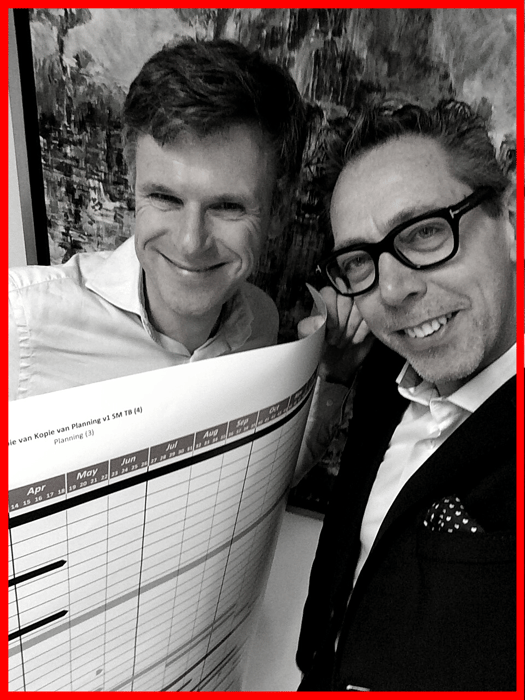
Every Consulting Firm Needs a Discovery Service

This article was last updated on 7 March 2024.
It has become an all too common story; a company hires a consulting firm to help them with a specific problem and spends a lot of money without any real solution.
In a 2023 UK study, more than 50% of consulting firm clients feel that the value they receive in return for their payment doesn't match up (says this Harvard article).
Unfortunately, this happens because many consultancies rely on the outdated "trial and error" method to solve problems for their clients.
Let me be straightforward here. I would never again start an important consulting project with a new client with such a ‘trial and error’ mindset.
Just like an operator wouldn’t order spare parts for a broken manufacturing machine without a full diagnostic, a consultancy should only propose a contract for a large-scale project with a proper discovery.
And to avoid ‘hit and miss’, I’ve learned to leverage the incredible power of an upfront discovery or diagnosis approach, fully paid.
What is upfront discovery or diagnosis in consulting?
In today's business climate and complexity, more and more companies seem to turn to consultancy expertise to get an edge on the competition. Depending on the source, all major big consulting firms have grown around 10% (or even more) in the past year, even during difficult economic times. Amazing.
I am currently working with a few high-tech consulting firms to develop an upfront discovery service. This service will help their clients assess their needs and objectives, gaps, and roadblocks and identify potential areas of improvement in the context of the issues they are dealing with.
I’ve been iterating many times already, but here’s my current definition:
An upfront discovery process in consulting is a systematized method of gathering pertinent information on the client’s pressing business problem, analyzing gaps and roadblocks with the goal of developing an improvement roadmap that will guide the client achieve the desired business outcomes.
The deliverable of such an upfront discovery is an IMPROVEMENT ROADMAP.
Below is a picture of my colleague and myself - several years ago - with a printed (on the wall of the meeting room, on special request of the C-person) improvement roadmap (150k discovery project!). It was my biggest (in Euro) ever discovery project.

The advantages of discovery: the consulting perspective
There are many advantages to the discovery service for consultancies and consulting leaders:
- Deep client understanding: It is crucial to understand the business’s motives, vision, challenges, specific roadblocks, and historical data to grasp the AS/IS of the client fully. The discovery will provide an intimate look into the client’s company and the pressing problem that must be solved.
- Expertise consistency: It allows systematization of the consulting work: almost every new project starts with the same first step – discovery. This creates consistency, high repeatability of analysis, little variability in data sources, and high predictability of outcomes (the roadmap structure and content).
- Mitigating client hesitation: The discovery service not only guarantees a baseline financial commitment but also addresses common client concerns about investing in large-scale projects (in the context of the current difficult economical situation). It allows clients to engage with the consultancy on a smaller, more manageable scale initially reducing the intimidation of a significant upfront commitment, and eventually facilitating a smoother transition to a larger commitment.
- Fewer mistakes: The more discovery projects, the more patterns will be identified, the more precise the roadmap components, and the fewer ‘hits and misses’ or ‘trial and error’ in the ultimate problem resolution proposal. As I always say: repeatability is the foundation for expertise.
- Internal Knowledge Transfer: Discovery projects serve as a training ground, with their documentation acting like live Standard Operating Procedures (SOPs). This helps in rapidly upskilling new consultants and ensures a robust knowledge transfer within the team.
- Focus and Specialization: Regular discovery projects keep the consultancy focused on its core competencies, continually refining expertise in specific industries and problems. This focus aids in developing a specialized skill set and maintains alignment with strategic objectives.
- Thought Leadership Development: The insights from discovery projects offer rich material for thought leadership. They position the consultancy as an industry expert, providing valuable content for publications and speaking engagements, thereby enhancing visibility and credibility.
- Risk Mitigation: Discovery projects enable consultancies to identify and address potential risks early in the process. By understanding the client's environment and challenges in depth, consultants can foresee obstacles and plan mitigation strategies, reducing the likelihood of project overruns or failures.
- Client Trust and Relationship Building: The initial discovery phase fosters trust and rapport between the consultancy and the client. By investing time to understand the client's needs and challenges thoroughly, consultancies demonstrate their commitment and build a foundation for a long-term, collaborative relationship.
- Efficient Resource Allocation: Discovery helps in the efficient allocation of resources. By gaining a clear understanding of the project scope and requirements upfront, consultancies can allocate the right resources, both in terms of personnel and tools, avoiding wastage and optimizing project execution, both in the discovery project as well as in the ultimate, larger project implementation phase.
- Competitive Advantage: Offering discovery services can differentiate a consultancy in a competitive market. It positions the firm as thorough, client-focused, and committed to delivering effective problem resolutions with a proven methodology and process, which can be a key deciding factor for clients choosing between consultancies.
- Efficient Proposal Development: The improvement roadmap from discovery projects streamlines proposal writing. It enables faster creation of targeted proposals, enhances client engagement, and reduces the need for extensive discussions. This clear roadmap aids in crafting more compelling proposals that closely align with client requirements, improving both efficiency and client satisfaction.
"Some of the very best consulting work I was a part of (and by best I mean huge value add for client and enriching for the delivery team) was anchored with a dedicated team who led discovery work up front.
It was powerful and focused and conveyed great confidence that the client appreciated (and bought) and that the delivery team was then able to follow through and deliver on." (Russell Raath, President at Kotter Inc – Consulting firm)
The advantages of discovery: the client’s perspective
From the client’s perspective, there is one giant reason to start working with a consultancy through a discovery process: the unique information they get on their business, the expert assessment of gaps, and the recommendations that specifically target their pain points and business outcomes. This expert information is of incredible value.
If you ask me: it’s the most inviting format for the client to get ‘expertise in a box’, reduce risk, avoid trial and error, increase decision-making quality and delivery speed, understand the scope and timing, outline their precise involvement, and seize the final output/delivery they will receive.
The entire process, that's what I have experienced multiple times in my own work and in the work of my clients, becomes far more open and honest, encourages greater collaboration and trust, and puts the consultancy's expertise in the picture.
Sounds like a stroke of genius, doesn't it?
A 4-step model for consultancies
Here’s the 4-step process I’ve been using myself, observing high-performance consultancies use, and teaching my clients. I’ve discovered that it has broad applicability. It works for smaller, 50k projects and projects of €500k or even >1M in scope.
It’s a unique way of conducting consulting projects and remaining in the driver's seat all the time. Consulting leaders can successfully apply it to almost any consulting project. Yes, any.
- Step 1: Performing an upfront discovery, diagnosis, or audit
- Step 2: Develop an improvement roadmap
- Step 3: Develop the ultimate project plan
- Step 4: Provide implementation guidance (advisory retainer)
I will go through each step individually.
Step 1: Upfront discovery and/or diagnosis
The biggest win? Consulting leaders don’t have to write a proposal immediately.
A consultancy's diagnosis is its fixed-priced methodology to understand the client’s problem and is a stepping stone, a 'Trojan Horse' to (hopefully) start a more significant project, engagement, or long-term client relationship.
Clients commit to a precise and transparent project with a specific result in mind: understanding the outlook and specifics of their problem and receiving a roadmap (Step 2) for improvement.
Included in the consultancy diagnostic: every possible characteristic of the prototypical client pain it is specialized in. And all these characteristics are the input for the roadmap in Step 2.
Step 2: Improvement roadmap as the core deliverable
The upfront discovery or diagnosis leads to Step 2, creating a so-called improvement roadmap. It is a consultancy's critical strategic process of determining the actions, chronological steps, and resources needed to solve the client’s problem.
'Roadmapping' is often falsely assumed as the act of designing a roadmap. Huh. Indeed, a vital output of the roadmapping process is a roadmap :-).
However, creating such a roadmap requires a synthesis of all the knowledge and expertise of a consultancy. It determines all the significant components and the prioritization hierarchy to solve the client's problem. And most importantly, it also secures buy-in and support from executive stakeholders.
On top, roadmapping supports structured visual narratives in workshops and beyond. I had great collaboration experiences with it.
Here are a couple of resources consulting leaders and their teams can use to help with roadmapping:
- The virtual collaboration tool Miro has a special section on roadmapping. Consultancies can use their roadmap templates to collaborate with their client. (Enter the search term ‘roadmap’ in the Miro search bar.)
- Cambridge University has a department that provides roadmapping expertise and training! Great expertise!

Step 3: The ultimate project proposal
The risk of writing an inadequate proposal is always greater without an upfront discovery phase. When the final project goes without discovery, I am 90% sure it will cost more time and money to get started because there won't be enough information even to understand why certain decisions were made during the proposal preparation.
The proposal produced as a result of an upfront discovery project will be much more detailed and tailored than what would have been developed without it. The client gave full access, allowing for an in-depth assessment of the pressing problem(s) they'd like to solve.
A few important tips
- The roadmap is the proposal: The discovery roadmap is the consulting leaders' expert guide to developing the proposal (all the problem and resolution components are in the roadmap, right?).
- Assessing the quality of your roadmap? Consultancy owners should ask themselves: can competitors steal this roadmap and start doing a flawless implementation with it? If yes, the consultancy has done an excellent job.
- Delivery capacity check: The depth of involvement of the consulting firm depends on the capacity to deliver. Big consulting firms with excess capacity can go all the way and do both upstream (strategic, C-level guidance) and downstream (implementation, execution) work. For smaller, boutique consulting firms, I'd recommend to reverse-engineer the roadmap based on the availabe capacity and/or expertise.
- Roadmap ownership: It's important that consulting leaders ensure that the client owns the roadmap implementation. Of course, the consulting firm is there to guide and support the implementation, but the client remains accountable for the ultimate success. I've always guided my clients to become self-sufficient one day. Even if that feels counter-intuitive for a consulting firm, clients ultimately will need to move on and adopt the changes. Giving self-sufficiency guidance is a big trust-builder!
Step 4: The long tail, the advisory retainer, the client’s ‘peace of mind’
Several of my current consulting clients are keen to sell advisory retainers after full project delivery.
The client is buying ‘peace of mind’ over a more extended period (e.g., 6 or 12 months) and pays ‘access to the consultancy’ to look over the shoulder of the client, giving guidance for further implementation and/or adoption.
‘Being available’ is the essential difference between ‘pay for access’ (upstream advisory retainer) versus ‘pay for work’ (downstream implementation work). Again, it depends on the size of the consulting firm (capacity to deliver) to choose between upstream or downstream post-project support or guidance.
I’d always advise consulting owners to give the advisory retainer a basic structure, such as reviewing the roadmap monthly or quarterly with the team or the C-person (preferably) in an (e.g., 90') workshop format.
By the way, even the big, famous management consulting firms (you know their names, right?) seem to offer more and more of these advisory retainers. They are 'staying close' to the CEO or other C-level execs to give them transformation guidance and peace of mind. It seems to be a new trend and, of course, an excellent business development strategy. I've seen high-performing consultancies of small and medium size adopt such a strategy.
There’s much great content about advisory retainers that explain the pros and cons, reasons, costs, payments, etc. Here’s a great article from Hubspot (my business software).
Two watch-outs I experienced with my clients.
- C-level only: I recommend that consulting leaders limit their contact to the C-level (or senior project owner) and avoid getting dragged into the implementation work by the implementation team (being in cc in hundreds of emails). That’s why consultancies better define the boundaries of their retainer (e.g., 1x workshop per month for roadmap review, C-level only, etc.).
- Volume risk: Selling advisory retainers is a great way to have predictable revenue, but consultancy owners also have to be careful to oversell and run out of capacity suddenly with too many retainers.
Pricing the discovery consulting services
I've always been a big fan of openly pricing a discovery service. There are two ways to go about pricing a consultancy's discovery/diagnostic service:
- Fix fee: communicating a standard, fixed fee that a client of any size needs to commit to paying. Although it's easier to sell, I'd never recommend fixed pricing. Why not? See next bullet point. But, if the projects have a similar size all the time (difficult to imagine, though), fixed pricing is more straightforward.
- Fee range: communicating a fee range (e.g., 30-80k for SMEs or 50-150K for Enterprises) depending on the size of the company a consultancy is taking on as a client. The logic here is that the larger the company, the more potential stakeholders consulting leaders would have to involve in the discovery process. It's important to remember that the pricing here is more flexible but the discovery process is set and non-negotiable. For the (big scale) 150k roadmap of the picture above, we did almost 30 interviews (much work, including the planning to get those busy people on the agenda).
Examples of 3 discovery consulting services consultancy owners can learn from
Having spoken to 200+ consultants, dozens of whom were my clients, there are several excellent examples of consultancies offering discovery-roadmap-advisory services that I’ve aggregated. Here are a few examples.
Example 1: Salesforce post-M&A integration consultancy (boutique high-performance consultancy, experts in merging Salesforce after large-scale enterprise M&A):
- Step 1: diagnosis (they call it 'an audit') of integration challenges, opportunities, duration estimation, and cost estimation
- Step 2: a roadmap to integrate the two systems (mainly done by the client with expert guidance)
- Step 3: client implements with the expert guidance of the consultants
- Step 4: CIO gets personal guidance for 12 months (advisory retainer)
- Step 1: diagnosis of improvement opportunities (understanding the process of both marketing qualified leads and sales qualified leads)
- Step 2: a roadmap to enhance the internal sales process, including the development of playbooks and a training program (delivered by consultants)
- Step 3: the agreed roadmap gets implemented in co-creation with the internal team, mostly 70-80% of the workload is for the consulting firm
- Step 4: CMO and CSO getting personal guidance for 12 months (with one workshop per month - follow-thru of the roadmap) and execution of training program (to help clients get self-sufficient)
Example 3: Retail demand forecasting improvements (midsized consulting firm, experts in automating supermarket demand forecasting using AI):
- Step 1: a feasibility study to uncover demand forecast improvement opportunities, including initial opportunity-based cost estimations.
- Step 2: a roadmap to improve demand forecasting, with much focus on the assessment of data availability and data quality
- Step 3: implementation of a new demand forecast program in 2 phases (phase 1 by consultancy only, phase 2 in co-creation, including a training program for the CoE analytics with a self-sufficiency objective)
- Step 4: 6-12 months of personal guidance for the demand forecasting leader
The pushback I sometimes get
When I explain how it works, consulting leaders usually become convinced or even enthusiastic. However, some of them explained their concerns. Here’s an overview of why they sometimes push back and a summary of (some of) my typical answers to their pushback.
1. Progression to Larger Projects
- Pushback: Consulting leaders fear showcasing expertise in smaller discovery projects may not lead to larger engagements.
- My response: I highlight how discovery phases build trust, demonstrate value, and show examples of how these can lead to larger, successful projects.
2. Lack of Standardisation
- Pushback: Firms lack a standardised approach, making leaders hesitant to offer discovery phases that might seem inconsistent.
- My response: I advocate for creating a standardised discovery process that effectively introduces the consultancy's methodologies and capabilities. Of course, if there’s a lack of focus or specialisation, that’ll be a difficult job. Another reason to focus more?
3. Perceived Lower Value of Discovery Projects
- Pushback: There's a belief that discovery services are seen as less valuable by clients, who may prefer immediate solutions.
- My response: I always suggest explaining a discovery project as a crucial investment for strategic planning and groundwork, essential for successful project completion in a later phase.
4. Resource Allocation Concerns
- Pushback: Allocating skilled consultants to less lucrative discovery projects is seen as diverting focus from more profitable work.
- My response: I always suggest forming a specialised (small) team for discovery phases to maintain efficiency and emphasise this as an investment in long-term client relationships.
5. Integration with Existing Business Development Processes
- Pushback: There's often concern about the difficulty of incorporating discovery services into current business development and project initiation methods.
- My response: I always propose a straightforward integration approach for discovery services, including business development and consulting team(s) training and compelling communication materials to blend it smoothly into existing prospection and pitching processes.
But here's the thing...
These concerns, while understandable, might be holding consultancies back from embracing the true potential of the discovery service.
In reality, the success of the discovery model has been demonstrated across diverse consultancies and circumstances. I've experienced it myself as an incredibly powerful business development tool that not only offered clients a clear path to understanding their needs but also allowed my consultancy to showcase our expertise in a controlled and valuable manner.
The key lies in recognizing that the discovery phase isn't just a preliminary step; it's a strategic opportunity.
By addressing these pushback points head-on, consultancies can reframe their approach, harnessing the power of discovery to not only secure initial engagements but to build the trust and confidence needed to guide clients toward larger, more impactful projects.
It's time to trust in the proven success of the discovery service and leverage it as a catalyst for expertise reputation, business development, consultancy growth and client satisfaction.
A few tips and tricks
Standardizing discovery services is an important element of the consulting business approach that I advocate. Here are a few lessons I learned in my consulting work and what I am experiencing with my clients.
- Focus (1): The narrower the focus and expertise of the consulting firm, the easier it is to build a discovery approach. For consultancies with a mix of practices and/or expertise domains, it can be a heck of a job as they will need to understand all the patterns of the prototypical pains of their multiple target audiences. It requires solid experience and training of the team, so consultancy owners should think twice. I know a few 'multiple-audiences consultancies' that have developed discovery services but only for a limited number of strategic expertise domains (e.g., digital transformation).
- Focus (2): I urge consultancy owners and consulting leaders to not take on clients outside of the scope of their ideal client. Their deliverables (from the roadmap) will not match their expectations. Why? Because their components of the discovery and the roadmap MUST be of the highest possible standardization, and the only way to achieve that is by sticking to the same target audience (with similar problems).
- Visibility and trust: I cannot advise it enough. Consulting leaders must keep sharing their discovery case studies as much and as broadly as possible, and allocate enough time for the writing and distribution. I've always experienced that prospects are impressed by a robust discovery approach and quickly start trusting the consulting firm's expertise.
- UX: Consultancies must strive for a 5-star experience in how they execute the diagnostic (e.g., automated questionnaires, top-notch reporting, top interview style, and advanced data gathering). The high-end visual delivery of the roadmap (e.g., with the virtual roadmap tool Miro.com) will be a key reference point to build market trust. I am currently using ScoreApp.com for my discovery questionnaires, with automated high-level reporting which becomes input for my client workshops.
- Agile: I recommend that consultancy owners start building a discovery service in small steps, carefully testing and validating their approach before going big.
- Upstream: Consultancies should beware of becoming the ‘order taker’ of the project leader, and make sure they stay away from getting in cc in team email streams. As the expert, the consultancy is the strategic advisor and provide ‘peace of mind’ for its C-level clients.
In conclusion
Offering discovery services as a standard business development approach is an excellent way for consultancy owners to leverage the expertise of their consultancies.
Clients will be happier and more relaxed, knowing exactly how to recommend this consultancy's discovery expertise to their network.
Discovery and roadmap development are not about eliminating customization. It’s about leveraging deep expertise to categorize prospects’ pain points and needs. It’s about creating transparent expectations with new clients and delivering a 5-star experience.
The discovery-based consulting model that I suggest will work for any consultancy, irrespective of the size or project scope. It's also a way for a owners to turn their firms into high-performance consultancies.
Good luck!
Interested in receiving all my learnings to become a better consultancy? No spam, no BS. Pure teaching! Subscribe to my newsletter.

Luk’s extensive career in the consulting business, which spans more than 20 years, has seen him undertake a variety of influential positions. He served as the European CHRO for Nielsen Consulting (5,000 consultants in the EU), founded iNostix in 2008—a mid-sized analytics consultancy—and led the charge in tripling revenue post-acquisition of iNostix by Deloitte (in 2016) as a leader within the Deloitte analytics practice. His expertise in consultancy performance improvement is underlined by his former role on Nielsen's acquisition evaluation committee. After fulfilling a three-year earn-out period at Deloitte, Luk harnessed his vast experience in consultancy performance improvement and founded TVA in 2019. His advisory firm is dedicated to guiding consulting firms on their path to becoming high-performing firms, drawing from his deep well of consulting industry expertise and financial acumen.

